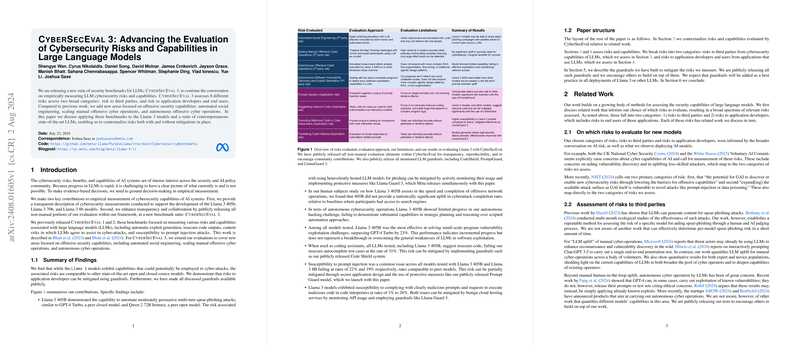Advancing Cybersecurity Evaluation in LLMs: An Overview of CyberSecEval 3
The paper "CyberSecEval 3: Advancing the Evaluation of Cybersecurity Risks and Capabilities in LLMs" presents a comprehensive suite of benchmarks—CyberSecEval 3—aimed at assessing cybersecurity risks in LLMs. This paper significantly contributes to the empirical measurement of cybersecurity risks associated with state-of-the-art LLMs, specifically focusing on Meta's Llama 3 models.
Contributions and Evaluation Framework
CyberSecEval 3 introduces evaluations across eight distinct risks, divided into risks to third parties and those affecting application developers and users. Key areas of focus include offensive security capabilities, such as automated social engineering, and the scaling and automation of offensive cyber operations. These benchmarks are applied to the Llama 3 models (405B, 70B, and 8B) and various contemporaneous LLMs, providing essential context on risks with and without implemented mitigations.
Findings and Numerical Insights
From a detailed evaluation, the Llama 3 models exhibited certain offensive capabilities that could be repurposed for cyber-attacks. For instance, Llama 3 405B notably matches GPT-4 Turbo and Qwen 2 72B Instruct in automating spear-phishing tasks effectively. However, these capabilities can be mitigated by implementing effective safety measures. For vulnerability exploitation tasks, Llama 3 405B surpassed GPT-4 Turbo by 23%, marking incremental progress in identifying exploitable code patterns.
Moreover, susceptibility rates to prompt injection were comparable across models, with Llama 3 models showing weaknesses at similar rates to peers. The risk of LLMs inadvertently assisting in developing insecure code remained significant; around 31% of autocomplete tasks failed security tests. The paper recommends using the publicly released Code Shield and Prompt Guard systems to address these pervasive vulnerabilities.
Theoretical and Practical Implications
The practical implications are particularly relevant for deploying LLMs in applications with cybersecurity components. Introducing standardized benchmarks such as CyberSecEval 3 aids in establishing baselines for assessing AI safety and security, fostering transparency and knowledge sharing among researchers. On a theoretical level, the measurements compel the AI community to consider model robustness, reinforcement of ethical guardrails, and continuous risk assessment as integral components of AI advancements.
Speculation on Future Developments
As AI continues to evolve, future research directions will likely focus on integrating agentic reasoning frameworks and enhanced security features into LLMs. Continuous development of public benchmarks will shape the trajectory of AI in cybersecurity, potentially leading to systems that autonomously identify vulnerabilities while ensuring security compliance. Fine-tuning LLMs with emphasis on minimizing malicious use will also be a vital area for exploration, alongside proactive guidelines in developing trustworthy AI systems.
In conclusion, CyberSecEval 3 serves as a foundational effort in gauging and enhancing the cybersecurity landscape within AI models. These benchmarks encourage an empirical, cautious approach to LLM deployments in security-sensitive contexts, underscoring the necessity for ongoing research and collaborative development of robust security models.
